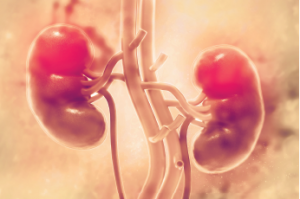
A study shows no increased risk of chronic kidney disease from allopurinol use in newly diagnosed gout patients who start out with normal or near-normal kidney function.
crystal light/shutterstock.com
WASHINGTON, D.C.—Taking high-dose non-steroidal anti-inflammatory drugs (NSAIDs) with a TNF inhibitor as an ankylosing spondylitis (AS) patient is linked with a 61% decrease in the chances your disease will progress, suggesting there may be a synergy when the drugs are used together, according to a longitudinal observational study from researchers at the University of California, San Francisco (UCSF).
The findings were highlighted at the 2016 ACR/ARHP Annual Meeting in a Discovery abstract session that also included findings on allopurinol and chronic kidney disease in gout patients and the effects of poverty on SLE damage.1
NSAIDs & AS
TNF inhibitors and NSAIDs have shown mixed results in preventing AS progression. Researchers set out to gauge the benefit seen in those taking TNF inhibitors and NSAIDs together. They looked at 538 patients in the Prospective Study of Outcomes in Ankylosing Spondylitis, with patients followed for at least two years and a median of four. X-rays were collected every two years, with a determination of progression by mSASSS, the modified Stoke Ankylosing Spondylitis Spinal Score.
Among patients not exposed to NSAIDs or exposed only to low doses, there was no benefit in taking TNF inhibitors alone.
But there was a significant benefit observed for those taking a high-dose NSAID along with an anti-TNF over those taking a high-dose NSAID but not an anti-TNF. The odds of progression were decreased by 61% for those taking both an anti-TNF and high-dose NSAIDs (P=0.04). Researchers found an interaction between the NSAID and TNF inhibitor use after adjusting propensity scores to address confounders introduced by the drugs’ indications.
“Another way to look at the estimated probability of progression by treatment group is to stratify it by TNF inhibitor use,” said Lianne Gensler, MD, director of the Ankylosing Spondylitis Clinic at UCSF. “When you look at the patients with high-dose NSAIDs, you can see that their estimated probability of progression is significantly lower when using TNF inhibitors—almost a 50% reduction in fact.”
‘Therapy for gout with allopurinol does not appear to have a harmful effect on renal function,’ Dr. Vargas-Santos said.
She said that this suggests a “synergistic effect” not seen when the therapies are used separately.
“I want to be clear that this is a longitudinal observational study and it does not prove causality,” Dr. Gensler said. “There are still unmeasured confounders that may possibly be playing a role.”
Asked whether she would now recommend that patients on TNF inhibitors automatically take continuous NSAIDs, she gave a firm “no.”
“I would love to see a randomized controlled trial to prove causality, but at the end of the day, we treat patients based on symptoms,” she said. “And if patients have absolutely no disease activity by symptoms on a TNF inhibitor, I would never tell them to add an NSAID.”
Allopurinal & Gout
In another study, researchers found that there was no increased risk of chronic kidney disease (CKD) of at least Stage 3 from the urate-lowering therapy allopurinol use in newly diagnosed gout patients who start out with normal or near-normal kidney function.2
Physicians are cautious about using allopurinol in patients with CKD, using lower dosing or not using it at all, and about 20% of people with gout have CKD. But data are limited for those with normal kidney function who take allopurinol.
Researchers examined data from The Health Improvement Network, a general practitioner electronic medical records database that is meant to represent the general U.K. population. Drawn from about 44,000 patients, 13,685 patients who began allopurinol during the study period were matched with 13,685 nonusers. The groups were similar demographically, in their comorbidities, in the other medications they were taking, and in lab data, said Ana Beatriz Vargas-Santos, MD, a rheumatologist who was a research fellow at Boston University School of Medicine.
Among the allopurinol users over an average follow-up of four years, there were 1,384 cases of CKD Stage 3 or higher, and 1,372 among the allopurinol nonusers, a difference that was not significant (hazards ratio 0.99, 95% CI 0.92–1.07).
“This is an important message for healthcare providers, highlighting that therapy for gout with allopurinol does not appear to have a harmful effect on renal function,” Dr. Vargas-Santos said.
Financial Impact on Disease
Researchers at UCSF found that SLE patients who were poor from 2003 through 2009 accrued more disease damage through 2015 than those patients who were not poor.3 Most of the difference came from patients with the highest “dose” of poverty, with patients poor during the entire period accruing twice as much damage as those who were never poor. The differences were not as stark between those were never poor and those who were poor during only some of those years, suggesting that withdrawal from poverty could improve results.
“The relationship between poverty and damage accrual meets epidemiological criteria for plausibility based on dose-response and withdrawal of exposure,” said Edward Yelin, PhD, professor in residence of medicine and health policy at UCSF. “The next steps are to explore why poverty may lead to increased levels of damage accrual.”
Living in areas of concentrated poverty, as well as stress levels, could be two mechanisms involved, he said. Researchers found that there was a significant difference in SLE damage accrual between those who were poor living in areas of concentrated poverty and poor patients not living in areas of concentrated poverty. Being poor and reporting high stress also was linked to higher damage accrual, they found. Furthermore, those living in poverty are about twice as likely to experience high levels of stress—66% to 37%.
“Reducing damage in lupus may require efforts to reduce the stresses associated with poverty,” Dr. Yelin said. “For example, advocating for an increased level of economic assistance and social services, including means to leave areas of concentrated poverty through housing vouchers.”
Thomas Collins is a freelance medical writer based in Florida.
Miss Any of These Important Sessions?
If you missed any of these important sessions, find them on SessionSelect.
References
- Gensler L, Reveille J, Lee M, et al. High dose nonsteroidal anti-inflammatory drugs (NSAIDs) and tumor necrosis factor inhibitor use results in less radiographic progression in ankylosing spondylitis—a longitudinal analysis [abstract 1956]. Arthritis Rheumatol. 2016;68(suppl 10).
- Vargas-Santos AB, Peloquin C, Zhang Y, et al. No increased risk of chronic kidney disease with allopurinol use [abstract 1957]. Arthritis Rheumatol. 2016;68(suppl 10).
- Yelin E, Yazdany J, Trupin L. Effect of poverty status in 2009, % of year in poverty between 2003 and 2009, and existing poverty permanently by 2009 on SLE damage in 2015 [abstract 1958]. Arthritis Rheumatol. 2016;68(suppl 10).


